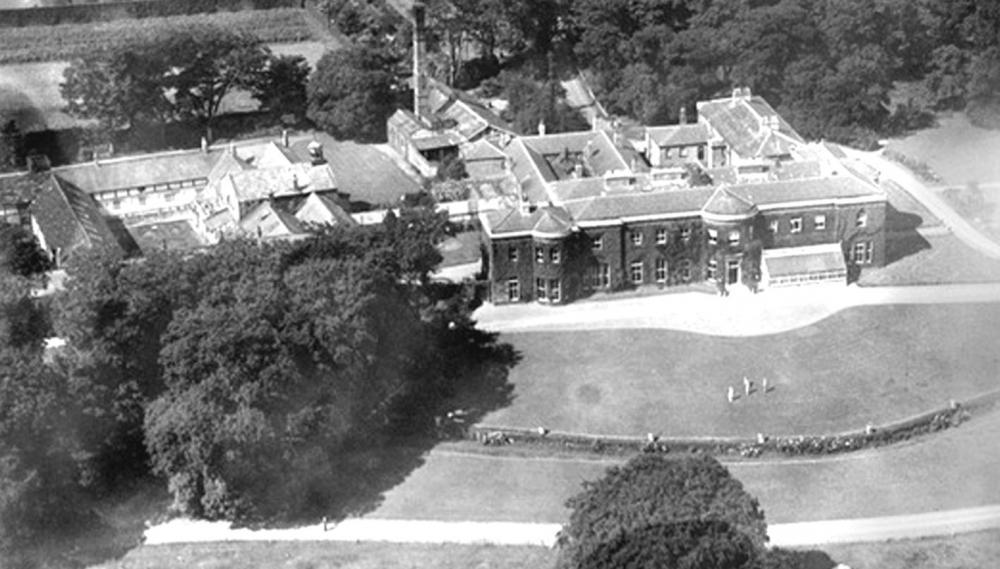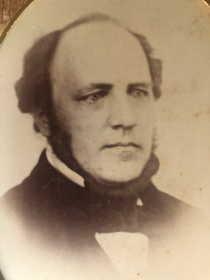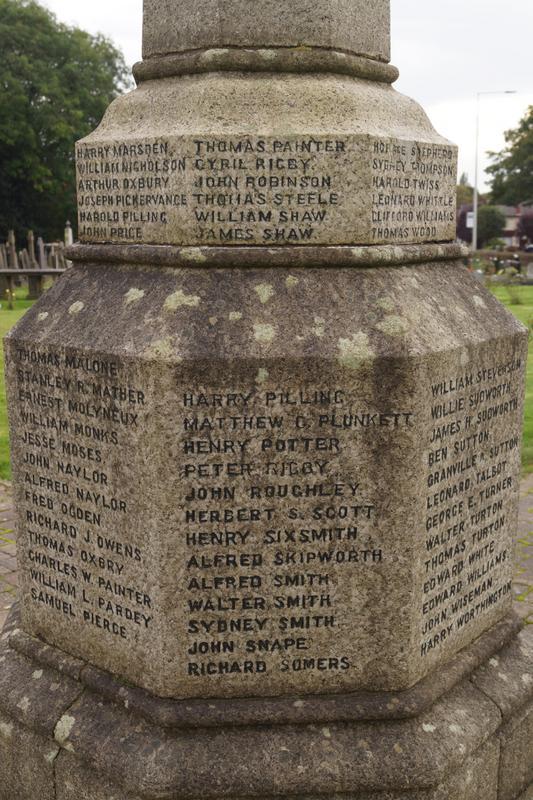
Herbert Stanley Scott was born at Marsh House, Ossett on 4th December 1897; he was baptised at St. Thomas Church, Ashton in Makerfield on 2nd August 1898. Herbert was the eldest son of three born to Roxburgh farmer Thomas Scott and Heckmondwike lass Lucy (nee Sykes) who married at Prestwich Register Office on 19th October 1896. Thomas, aged 27, was a gardener living at Haydock Lodge and Lucy, 29 years old, was living at Hilton Lodge Prestwich which, about that time, was a colonial gentleman’s club offering a range of sports centered on bowls and lawn tennis. It subsequently became Prestwich Golf Club.
A year later at Herbert’s birth in December 1897 the couple were living at Marsh House Ossett, where Thomas was working as an attendant. By August 1898 they had returned to Lancashire and were living at Heath Road, Ashton in Makerfield; Thomas worked as an attendant at Haydock Lodge.
Haydock Lodge was just several hundred yards outside Ashton in Makerfield where a large number of staff, including Thomas and Lucy, lived. In the mid nineteenth century it was the scene of a scandal that almost brought down the government of the day. England’s Poor Law Commissioners and the Trade in Pauper Lunacy 1834-1847 (studymore.org.uk) It was run by a Charles Mott whose behaviour was reprehensible in the cruel treatment of the patients and the associated high death rates. When Mott’s failings were discovered subsequent enquiries resulted in major changes to the way mental patients were looked after and reinforced with new laws. The hospital closed in 1970. The Post House hotel, now the Holiday Inn, was later built on the site.

1927 view of Haydock Lodge mental hospital. Photo: Courtesy of Keith Beckett
Their second and third sons, Thomas Saville Sykes and Frederick Dixon Sykes were born in early 1897 (at Flora Street Ashton) and late 1900 (at Laburnum Road) respectively. In 1901 Herbert’s parents, Thomas, an asylum attendant, and Lucy were still living at Laburnum Road, Ashton in Makerfield, with their three sons Herbert, Thomas jnr and Frederick. Thomas was 31 years old and even though she was born in late 1860 and aged 40 Lucy claimed to be 33. Sadly Lucy Agnes died on 11th August 1903, aged 35 years or, more truthfully, 42 years old. She was buried at St. Thomas Church Ashton in Makerfield just three weeks after the birth of twins Lucy Gwendoline and Frank Leslie born on 20th July 1903 when the couple were living at Warrington Road.
Lucy had spent the first thirty years of her life living with her parents and siblings in her birth town of Heckmondwike. Her father, William, a solicitor and brewer, died in 1887 and in 1891 Lucy was “ living on her own means” in Heckmondwike with her brother Herbert Augustus, a common brewer, and sister Clara. Their father, William, died in 1886 and their mother, Mary died in 1887.
 It’s interesting to speculate why Lucy and Thomas were in Ossett in 1897 for the birth of their first child, Herbert. Thomas was now working as an attendant at Marsh House in Ossett which, like Haydock Lodge, was a mental hospital. Perhaps that was the link or perhaps there was another reason for their attendance there.
It’s interesting to speculate why Lucy and Thomas were in Ossett in 1897 for the birth of their first child, Herbert. Thomas was now working as an attendant at Marsh House in Ossett which, like Haydock Lodge, was a mental hospital. Perhaps that was the link or perhaps there was another reason for their attendance there.
 Lucy’s father, William Sykes (opposite), was a solicitor and brewer who lived and worked in Heckmondwike. He died in 1886 and records show that by 1888 William Sykes – Heckmondwike owned The Royal Oak on Owl Lane Ossett. The Royal Oak was also known as “The Barracks” and you can see more about the Public House and much more at this link to the Ossett Heritage History website. The site includes Douglas Brammer’s book of Sketches of Past Times – Flushdyke and Ossett
Lucy’s father, William Sykes (opposite), was a solicitor and brewer who lived and worked in Heckmondwike. He died in 1886 and records show that by 1888 William Sykes – Heckmondwike owned The Royal Oak on Owl Lane Ossett. The Royal Oak was also known as “The Barracks” and you can see more about the Public House and much more at this link to the Ossett Heritage History website. The site includes Douglas Brammer’s book of Sketches of Past Times – Flushdyke and Ossett
Gallery – Ossett Heritage
We have read that Herbert’s mother, Lucy Sykes, died in 1903 shortly after she gave birth to twins. Lucy was 43 years old. In 1911 three of the Sykes children Herbert Stanley, Thomas Saville and Lucy Gwendaline were all of school age and lodging at Park Cottage, Haydock Lodge. Their father Thomas Scott and siblings Frederick Dixon Sykes and Frank Leslie Sykes appear to be elsewhere but it seems that Haydock Lodge remained home to the Sykes family as war with Germany threatened.
Herbert Stanley Sykes was just sixteen years of age in August 1914 when Great Britain declared war on the German Empire and too young to go to war. His Army Service record did not survive but we do know that he enlisted at his home town of Ashton in Makerfield and we also know that he did not serve overseas before 1st January 1917 by which time he was nineteen years of age. It’s likely that he signed on in late 1915 or early 1916; perhaps as early as his 18th birthday in December 1915. Officially he shouldn’t have served overseas until his nineteenth birthday in December 1916. This information and his six digit service number, 201987, suggests he didn’t serve overseas until early 1917.
Herbert Stanley served with the 2nd/5th Manchester Regiment which was formed as a Territorial regiment at Wigan in August 1914 in response to the outbreak of war. By November 1914 it had come under the orders of the 199th Brigade of the 66th Division. The regiment remained in Lancashire until May 1915 and in March 1916 it moved to Colchester in readiness for its mobilisation for war in February 1917. They set out in early March and Herbert Stanley Scott was most probably with them.
Two convoys left dock in early March 1917, one from Southampton and one from Folkstone; the first needed to re-dock and sailed again on 13th March disembarking at Le Havre . The Folkstone sailing was less troublesome and the “Princess Henrietta” sailed on 6th March. 3 officers and 811 other ranks (some for Salonika – 2 officers and 331 other ranks for France) arrived at Boulogne later that day. The Regimental Diary records that “No submarines were sighted”.
Belgian built Princess Henriette – Troop ship which carried the 2nd/5th Manchesters to war
Used prewar on the Dover – Ostend fast mail-steamer service, during the war she acted as a troopship based at Folkestone, sailing back and forth over the English Channel. She survived the war and returned to cross channel civilian service until she was scrapped in 1922.
On 9th March nine officers and 180 other ranks proceeded in London Busses and Lorries to Front Line Trenches at Cambrin (near Bethune), France where Private Herbert Stanley Scott remained until late June 1917. The trenches were in poor condition and the rest of March and April was relatively quiet, in and out of trenches, with cold weather snaps, sun and snow with increasing enemy artillery activity and gas attacks causing losses of forty British soldiers in April. Another 25 were killed in May.
June saw the British successfully raid the German front line on the 8th but nonetheless 4 men were killed and 48 wounded from the 2nd/5th Manchester Regiment. The casualty list did not include Herbert Stanley’s name. In late June the whole Regiment, comprising 984 men entrained the fifty miles to St Pol (Dunkerque). The British suffered significant shelling until mid July 2017 but suffered few losses. Then came the fateful day.
This day, 22nd July 1917, was to be his final day. Private Herbert Stanley Scott was killed in action; Herbert was nineteen years of age. The Regimental Diary recorded for that day;
At 12 midnight last night enemy artillery active with 4.2 shells on to and all round Battalion H.Q. and continued up to 5 a.m. Casualties 11 Other Ranks} 5 killed, 6 wounded. Weather Fine warm. 
2nd /5th Manchester Regiment Casualties 22nd July 1917
Private Herbert Stanley Scott was posthumously awarded the British and Allied Victory Medals in recognition of his service overseas in a theatre of war.
He is Remembered with Honour at COXYDE MILITARYCEMETERY @ Plot I. J. 61.
In June 1917, Commonwealth forces relieved French forces on 6 kilometres of front line from the sea to a point south of Nieuport (now Nieuwpoort), and held this sector for six months. Coxyde (now Koksijde) was about 10 kilometres behind the front line. The village was used for rest billets and was occasionally shelled, but the cemetery, which had been started by French troops, was found to be reasonably safe. It became the most important of the Commonwealth cemeteries on the Belgian coast and was used at night for the burial of the dead brought back from the front line.
The cemetery now contains 1,507 Commonwealth burials of the First World War, the French graves from this period having since been removed. Of the 155 Second World War burials, 22 are unidentified.
All that Herbert had in the world at the time of his death on 22nd July 1917 he left to his father, Thomas Scott of Haydock Lodge. Thomas died on 5th November 1923, aged 53, at Liverpool Infirmary and is buried at St. Thomas Church Ashton in Makerfield; the same Church in which Herbert Stanley was baptised on 2nd August 1898.
Left; Thomas Scott (1870-1923). Father of Herbert Stanley Scott

Herbert Stanley Scott is remembered at the St. Thomas, Ashton-in-Makerfield War Memorial (Above). The town also has a roadside sensory garden with benches and interpretative plaques, all of which are constructed in steel and carry a common motif of silhouettes of a group of soldiers on the march, painted black, with red-painted bunches of stylised poppies on the right-hand end of each object.
In 2022, Herbert Stanley Scott, once fleetingly of Ossett, will be remembered at the Ossett War Memorial in the Market Place where his name will be inscribed alongside his brothers and sisters in arms; the Ossett Fallen.
Herbert Stanley Scott was discovered and brought to our attention by an independent researcher who prefers to remain anonymous. The research in this biography was undertaken and written solely by Alan Howe for Ossett Heritage in February 2022.
Sources
Commonwealth War Graves Commission
Family photographs courtesy of Jeannette Cimelli